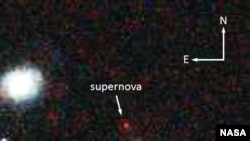Scientists have confirmed the discovery of the oldest and most distant supernova ever photographed.
The faint remnants of the exploded star, more than 10 billion light-years distant, offer new clues to the formation of the early universe.
Rubin hopes to continue this work and measure dozens more distant supernovae at the edges of the visible universe. He says those efforts will be aided not only by new generation of instruments aboard the Hubble Space Telescope but also by the even more powerful instruments that will be aboard Hubble’s successor telescope, due to be launched in several years.
The faint remnants of the exploded star, more than 10 billion light-years distant, offer new clues to the formation of the early universe.
When a massive star explodes, it’s called a supernova and is one of the most violent events in the universe. The bright, distinctive remnants of these explosions can be seen throughout the cosmos, and they provide valuable reference points for astronomers trying to measure the expansion of the universe.
Scientists know the rate of that expansion is accelerating, but they don’t know why, says David Rubin, a member of the Supernova Cosmology Project at the University of California, Berkeley.
Scientists know the rate of that expansion is accelerating, but they don’t know why, says David Rubin, a member of the Supernova Cosmology Project at the University of California, Berkeley.
“We are currently working to make better and better measurements at greater and greater distance to pin down the source of the acceleration and determine its properties,” he said.
Ruben is studying type IA supernovae because they have uniform brightness, which means, he says, “If we observe a supernova and we observe its apparent brightness here on Earth, we can learn its distance. We can make a plot of the distance versus the expansion and try to distinguish various theories of acceleration.”
Using the Earth-orbiting Hubble Space Telescope, the astronomers first spotted the distant supernova in a deep-space survey. Its light was so dim it was nearly invisible, and researchers had to wait five years for a more advanced camera to be installed aboard Hubble to confirm that the tiny point of light really was a supernova.
Cosmic images from the American Astronomical Society meeting in Long Beach, California:
Rubin told the American Astronomical Society’s meeting in Long Beach, California, that the find was a breakthrough.
“This is the most distant supernova with a precision distance measurement," he said. "It is 10 million years old, so it dates back in time to when the universe was only about four billion years old, younger than the earth is today.”












